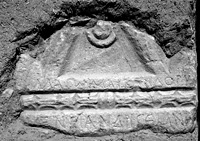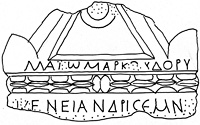 MAMA XI 284 (Northern Lykaonia)
MAMA XI 284 (Northern Lykaonia) 
Funerary stele of Dorymenes
- Type of monument:
- Funerary stele.
- Location:
- Zengicek (Koçyaka) (Northern Lykaonia): in a yard.
- Description:
- Upper part of stele with gabled pediment and acroteria, with decorative entablature; broken above and below. In the pediment, round boss.
- Dimensions:
- Ht. 0.38+; W. 0.58; Th. --; letters 0.025-0.040.
- Record:
- Line drawing; MB notebook copy; photograph (1956/129).
- Publication:
- None.
- Date:
- Roman imperial period.
Ματ̣ὼ (?) Μάρκο̣υ Δορυ-
μ̣ένει ἀνδρὶ σεμν[ο]-
[τάτῳ - - - - - - - - -]
Mato (?), daughter of Marcus, for her most noble husband Dorymenes...





Only the pediment and entablature of this stele survive; presumably the inscription continued on the shaft. The decoration of the entablature (and the disposition of the first two lines of the inscription) is very similar to that of a funerary stele from the neighbouring village of Zıvarık/Altınekin (MAMA XI 277 [1956/153]). The woman’s name in line 1 could be read as ΜΑΓ̣Ω or ΜΑΤ̣Ω. Since the former name does not appear to be attested elsewhere, I have assumed that the name should be read and accented Ματ̣ώ. The name is rare, but securely attested at Teos and Chios (LGPN I and V.A, s.v.); see Zgusta 1964: 304; Robert 1963: 343-4; Robert, OMS V, 310, n.256; OMS VII, 149.
The name Δορυμένης is distinctly rare elsewhere in the Greek world. Examples are known from Thasos (SEG 31, 764), Aitolia (SEG 33, 317; Lefèvre 2002: nos. 82, 98, 99; Polybios 5.61.9; SEG 7, 326; 2 Macc. 4.43-50; 1 Macc 3:32-9; Cotton and Wörrle 2007: 200-1), and Delphi (FD 34 III 420). Otherwise the name seems to be entirely restricted to the region between Ikonion and Lake Tatta in northern Lykaonia. I know of nine further examples of the name in this region:
(1) SEG 34, 1343 (Konya: Τιμόθεος Ἀττάλου Δορυμένους)
(2) I.Konya 5 (Sizma: Δορυμένης Βιάνορος)
(3) Sarre 1896: 32, no. 11 (Asarcık/Giymir, ancient Perta: Δορυμένης Μελεάγρου)
(4) MAMA VIII 249 (Kemçik, territory of Savatra: Ἥσυχος Ὀλβ̣ίου το[ῦ] καὶ Δορυμένους)
(5) Anderson 1899: 133, no. 161 (Eskil, south of Lake Tatta: Δορ[υ]μέ̣ν̣η̣[ς] Παπίου)
(6) MAMA XI 206 (1954/52, Kana: Ἀλέξανδρος Δορυμένου)
(7-9) MAMA VIII 289-91 (Akören/Oğuzeli, ancient Anzoulada (?): Δορυμέν(ης) Ζαυε̣ου, Δορυμήνης Ἀ̣λ̣εξάνδρου, Δομέτιος υἱὸς Δορυμένου)
In MAMA VII 589 (Çerkez Atlantı/Mahmudiye, territory of Aralla), it is not clear whether the name Δορμενη (gen.) is an indigenous name (Calder in MAMA VII and Zgusta 1964: 151 §300-3) or a misspelling of Δορυμένης. If the former, that may help explain why this rare name was so popular in this small region: it would, in that case, represent a Hellenization of a local indigenous name (cf. perhaps the name Δορυμειος at Laodikeia Katakekaumene, MAMA VII 55; Δορυμαγλης at Çavuşçu, on the territory of Tyriaion, I.Sultan Dağı 376).
The adjective σεμνός and the superlative σεμνότατος (line 2) are more usually applied to women than to men, but cf. MAMA XI 307 (1956/159a: Koçaş); 303 (1957/40: Karakaya); MAMA VIII 399 (Çavundur: territory of Anaboura); Robert, Hellenica XIII, 34-6, 41.